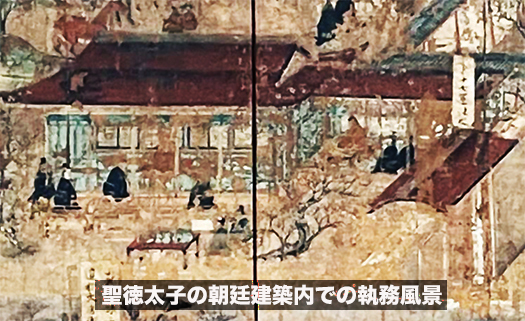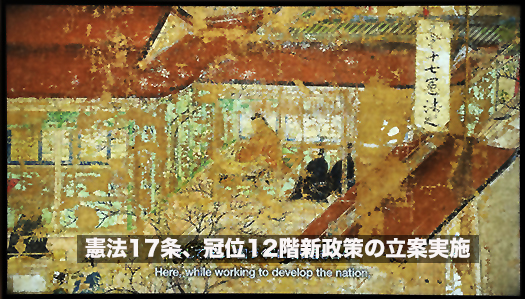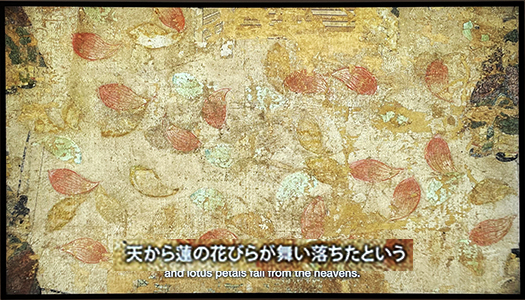

「法隆寺宝物館「聖徳太子絵伝」についての記事、第7回目の今回は、604年、聖徳太子32才の時に定めた基本法規である憲法十七条、そしてその前年の冠位十二階政策。
このシリーズの第一回はこちら→端正なモダニズム「法隆寺宝物館」探訪。
きのう見たような国内内戦の末に樹立された「仏法専制体制」がその後の政権の基本になっていく。乱を直接の引き金とした四天王寺の建立や法隆寺の建立など、仏教立国政策が推進された。
乱から5年後の593年聖徳太子21才の時に母方・父方両方の叔母、推古天皇の摂政に就任。蘇我氏は朝廷内をほぼその勢力下に収め、聖徳太子は乱での「戦功」もあってこの地位に就任しただろうことは間違いない。対外政策としては仏教を導入することを通して、東アジア世界での日本国家の地位確立の橋頭堡が築かれた。当時の世界の政治状況から考えれば、大きく台頭する隋・唐の体制がやがて採用していく「律令体制」という政治制度との対応が課題だったことだろう。
それまでの王権システムは蘇我氏や物部氏、大伴氏などの大土地所有の「氏」が実権を握っていてそうした勢力間での合従連衡・パワーバランスでのみ政権運営されていた。こういう体制では仏教受容がめざした世界共通価値感による「法の支配」は実現しない。
教科書で聖徳太子がめざしたものが「律令体制の確立、その先見者」とされるのは事実だったのだろうと思われる。しかし言うは易く、行うは難し。
憲法十七条の制定に当たって第1条に「和を以て貴しと為す」と定めたのは、それまでの大王の下で有力豪族たちが氏(ウヂ)として奉仕し王権を構成した制度では各氏の間での争闘が常態化していたことが基本認識としてあったのだろう。


国内政治状況から考えれば、物部氏の滅亡などの大きな内戦があって、そこからの安定的な状況を生み出す必要があったに違いない。3条までの現代口語訳は以下の通り。
「一曰く、和をもって尊しとし逆らわないのを教義とせよ。人は皆群れるしまた頭の達者な者は少ない。上が和らぎ下と睦まじく戯れにおいて事を論じれば、すなわち事の道理は自ら通じる。」
「二曰く、篤く三宝を敬え。それは仏法僧である。すなわち総ての生物の終わり帰るところであり、すべての国の頂点の教義である。低姿勢が良いとする法。」
「三曰く、天皇の勅語を承ったなら必ず謹んで従う。民を支配する者の規則は天までいたる。そうして四季がめぐり、総ての気で神通力を得る。君主の言葉を臣下は謹んで受ける。上が行なえば、下は真似をする。それゆえ、承る勅語は必ず慎み従う。慎まずは自敗する。」
また冠位十二階とは、ヤマト王権直属の「官僚」群を任命していくということであり、国政への氏姓有力豪族による関与を減じさせていく狙いがあったのだろう。
国家体制確立の始原期においてかれ聖徳太子に押し寄せた困難な状況が、こうした事跡に集中的に表現されている。しかし聖徳太子のこうした近代化政策は相当の軋轢を当時の支配構造に与えたに違いない。
English version⬇
[After seizing power, to the Buddhist priest “Sanpo” system The Gallery of Horyuji Treasures-7]
Prince Shotoku initiated the subsequent reforms to the “Ritsuryo” system. The basic policy of “Harmony is the key to nobility, and the three treasures are to be reverently respected. The “Three Treasures” system was established in the late 8th century.
In this seventh installment of our series of articles on the “Shotoku Taishi Eiden” in the Gallery of Horyuji Treasures, we look at the Seventeenth Article of the Constitution, the basic law established in 604, when Shotoku Taishi was 32 years old, and the Crown Twelve Ranks Policy of the previous year. Click here for the first article in this series→Exploring the neat modernism of the “Gallery of Horyuji Treasures.→端正なモダニズム「法隆寺宝物館」探訪。
The “Buddhist monarchy” established after the domestic civil war we saw yesterday became the basis of the subsequent regime. The rebellion directly triggered the establishment of the Shitennoji Temple and the Horyuji Temple, which promoted the policy of establishing a Buddhist state.
Five years after the Rebellion, in 593, at the age of 21, Prince Shotoku was appointed regent by his aunt, Emperor Suiko, on both his maternal and paternal sides. The Soga clan had the Imperial Court almost entirely under its control, and Prince Shotoku would no doubt have been appointed to this position partly because of his “war success” in the rebellion. As for foreign policy, a bridgehead for the establishment of the Japanese state in the East Asian world was built through the introduction of Buddhism. Considering the political situation in the world at that time, it was probably a challenge to cope with the political system called “Ritsuryo system” that was soon to be adopted by the emerging Sui and Tang regimes.
Until then, the system of kingship was governed by the Soga, Mononobe, Otomo, and other large landowning clans, and the government was managed only by the balance of power among these clans. Under such a system, the “rule of law” based on universal values, which was the goal of the acceptance of Buddhism, could not be realized.
It may be true that the textbooks describe Prince Shotoku’s goal as “the establishment of the Ritsuryo system and its forerunner. However, this is easier said than done.
In enacting Article 17 of the Constitution, Prince Shotoku’s first article stipulated that “harmony shall be the highest virtue.” This was probably based on his recognition that, under the previous system in which powerful clans served as “wuji” (clans) under a great king and constituted the royal authority, disputes among the clans had become the norm.
The following is a translation of the first three articles of the “Ki no Sho” (the first of which is translated into modern colloquialism as follows)
I say, “Make it a doctrine to respect harmony and not to disobey it. All men are gregarious, and few are wise. If the higher ups are at peace with the lower downs and discuss matters in amity, then the reason of things will be understood by themselves.
The second saying is, “Respect the three treasures with utmost reverence. They are the Buddhas, the Dharma Buddhas, and the Dharma Priests. It is the place to which all living beings return, and it is the doctrine at the summit of all nations. The Dharma says, “Low profile is good.
San says, “If you have received the emperor’s edict, be sure to obey it respectfully. The rules of those who rule over the people extend all the way to the heavens. Then the four seasons will rotate, and he will gain divine power with all his chi. The words of the sovereign are received with reverence by his subjects. If the higher-ups do, the lower ones will imitate them. Therefore, the words of the sovereign must be obeyed with reverence. Failure to do so will result in self-destruction.
The 12 ranks of the crown were intended to appoint a group of “bureaucrats” under the direct control of the Yamato royal authority, and were probably intended to reduce the involvement of powerful clans with family names in the affairs of state.
The difficulties that confronted Prince Shotoku during the initial period of the establishment of the state system are intensively expressed in these events. However, Prince Shotoku’s modernization policy must have caused considerable friction with the ruling structure of the time.
Posted on 6月 4th, 2023 by 三木 奎吾
Filed under: 歴史探訪







コメントを投稿
「※誹謗中傷や、悪意のある書き込み、営利目的などのコメントを防ぐために、投稿された全てのコメントは一時的に保留されますのでご了承ください。」
You must be logged in to post a comment.